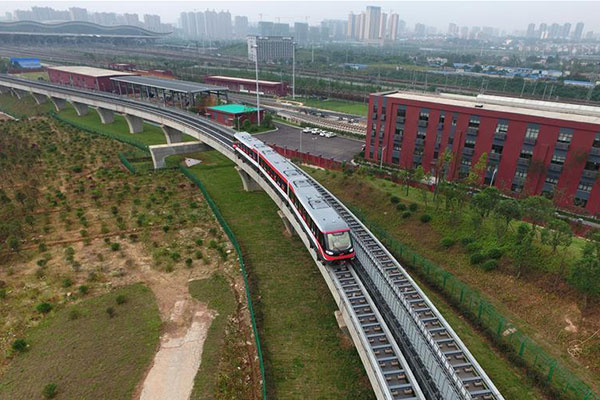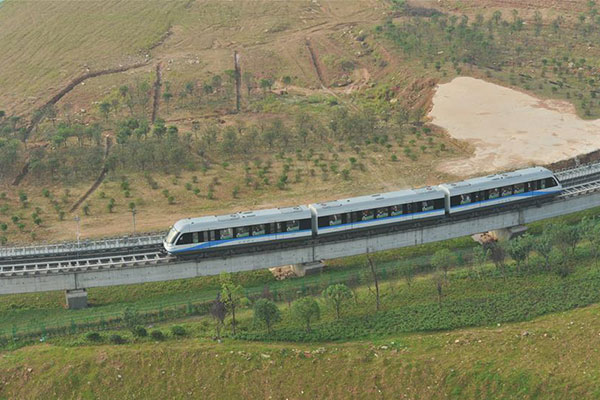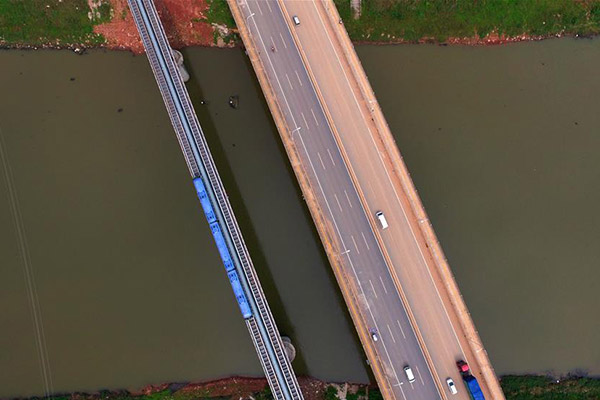
A train runs on the magnetic levitation line in Changsha, capital of central China’s Hunan province, May 6, 2016. A trial operation of China’s first domestically designed and manufactured magnetic levitation line started in Changsha on May 6. The maglev shuttles between Changsha’s south railway station and the airport. It takes about ten minutes to complete the 18.55-km journey, according to a statement from operator Hunan Maglev Transport Co. The 48-meter-long train can carry 363 people in three carriages. It can achieve a maximum speed of 100 km per hour. [Photo/Xinhua]
CHANGSHA — The first Chinese middle-to-low speed magnetically levitated (maglev) rail line began operating on May 6 in Changsha, capital of central China’s Hunan province.
The maglev shuttles between Changsha’s south railway station and the airport, with one stop in between. It takes 19 minutes and 30 seconds to complete the 18.55-km journey, according to a statement from operator Hunan Maglev Transport Co.
The train can carry 363 people at a maximum speed of 100 km per hour. The price of a one-way ticket is 20 yuan (about $3). Soon, airline passengers will be able to check in and deposit their bags at a new terminal in the railway station.

A train runs on the magnetic levitation line in Changsha, capital of central China’s Hunan province, May 6, 2016. A trial operation of China’s first domestically designed and manufactured magnetic levitation line started in Changsha on May 6. The maglev shuttles between Changsha’s south railway station and the airport. It takes about ten minutes to complete the 18.55-km journey, according to a statement from operator Hunan Maglev Transport Co. The 48-meter-long train can carry 363 people in three carriages. It can achieve a maximum speed of 100 km per hour. [Photo/Xinhua]
Construction of the maglev trains, designed and manufactured by CRRC Zhuzhou Locomotive Co., Ltd. in Hunan province, began in May 2014 with a total investment of 4.29 billion yuan.
Middle-to-low speed trains produce very little noise and occupy much less land than subways, according to CRRC representative Peng Qibiao.
The line costs between 150 million yuan and 250 million yuan per kilometer, making it highly economical compared to subways and light rail, which cost up to 800 million yuan and 300 million yuan per km respectively.
“The environmentally friendly maglev not only diversifies city transportation, but also creates a more harmonious relationship between cities and the environment,” Peng said.

A train runs on the magnetic levitation line in Changsha, capital of central China’s Hunan province, May 6, 2016. A trial operation of China’s first domestically designed and manufactured magnetic levitation line started in Changsha on May 6. The maglev shuttles between Changsha’s south railway station and the airport. It takes about ten minutes to complete the 18.55-km journey, according to a statement from operator Hunan Maglev Transport Co. The 48-meter-long train can carry 363 people in three carriages. It can achieve a maximum speed of 100 km per hour. [Photo/Xinhua]

A train runs on the magnetic levitation line in Changsha, capital of central China’s Hunan province, May 6, 2016. A trial operation of China’s first domestically designed and manufactured magnetic levitation line started in Changsha on May 6. The maglev shuttles between Changsha’s south railway station and the airport. It takes about ten minutes to complete the 18.55-km journey, according to a statement from operator Hunan Maglev Transport Co. The 48-meter-long train can carry 363 people in three carriages. It can achieve a maximum speed of 100 km per hour. [Photo/Xinhua]
